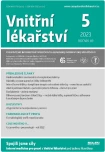Diabetes
We recommend


How Does Empagliflozin Stand in Terms of Diabetic Retinopathy Risk? We Have Answers Not Only from Controlled Studies but Also from Real Practice
Modern antidiabetics – gliflozins and glucagon-like peptide-1 receptor agonists (GLP-1RA) – significantly help improve the management of type 2 diabetes (DM2). In addition to reliable glycemic control, they offer other benefits. For example, gliflozins are known for their cardio- and renoprotective properties. GLP-1RA also reduce cardiovascular (CV) risk, though clinical evaluation (SUSTAIN-6) suggests a possible higher risk of retinopathy. This is also being investigated with gliflozins. How empagliflozin fares in this respect has been…

The Significance of Administering Gliflozins in Real Practice in Diabetics Without CV and Renal Disease
Current care standards recommend the use of sodium-glucose cotransporter 2 inhibitors (SGLT2i,…

Benefit of Empagliflozin in Patients with Chronic Kidney Disease – Results of the EMPA-KIDNEY Study
The sodium-glucose cotransporter 2 inhibitor (SGLT2i) empagliflozin is currently used to treat type…
Articles on this topic

Diabetic Nephropathy and COVID-19: Fatal Connection?
People with diabetes and diabetic kidney disease exhibit higher mortality and risk of severe…

Diabetic Foot Syndrome: An Unpleasant Scare for Diabetics and Their Attending Doctors
Diabetic foot syndrome is a very serious complication of diabetes mellitus (DM). It often…

Diabetic Retinopathy: A Blind Diabetic as Proof of Serious Neglect of Prevention
Diabetic retinopathy is the most common cause of blindness in working-age patients in…

DPP4 Inhibitors in Chronic Kidney Disease and Their Potential to Protect Against Diabetic Nephropathy
Preclinical and clinical observations suggest that dipeptidyl peptidase 4 (DPP4) inhibitors might...

Patient with Diabetes: When to Follow Up and When to Refer to a Specialist?
It is most often the general practitioner (GP) who first diagnoses diabetes. Whether during…

Gliflozins in the Treatment of Type 2 Diabetes According to Current Recommendations SVL
Gliflozins are a relatively new group of antidiabetics with a specific mechanism of action. In…

Case Study with Voting: Intensification of Type 2 Diabetes Therapy in a Chronically Treated Patient. How to Proceed According to Current Recommendations?
We have prepared an interactive case study for you with a 70-year-old patient with decompensated...

Desirable Side Effects of Antidiabetics
The days when diabetology was a field solely focused on normalizing blood sugar levels are…

Prescription Restrictions on Antidiabetics Authorized for Prescription by General Practitioners - Status as of October 2020
Diabetes mellitus (DM) has become an increasing problem worldwide in recent years. Long-term…

10 Properties and Benefits of Gliptins: How They Work and When to Prescribe Them
General practitioners can now prescribe oral antidiabetics from the group of gliptins to…
Subscribe
E-courses on this topic
Most read on this topic
Journal on this topic
Related topic
E-courses on this topic
Most read on this topic
- 10 Properties and Benefits of Gliptins: How They Work and When to Prescribe Them
- Gliflozins in the Treatment of Type 2 Diabetes According to Current Recommendations SVL
- How Diabetes Shortens Life or Mortality of Patients with Type 2 Diabetes
- Prescription Restrictions on Antidiabetics Authorized for Prescription by General Practitioners - Status as of October 2020
- What a General Practitioner Needs to Know About Gliflozins
- Mechanisms Connecting Diabetes Mellitus and Obesity
Journal on this topic
Related topic




